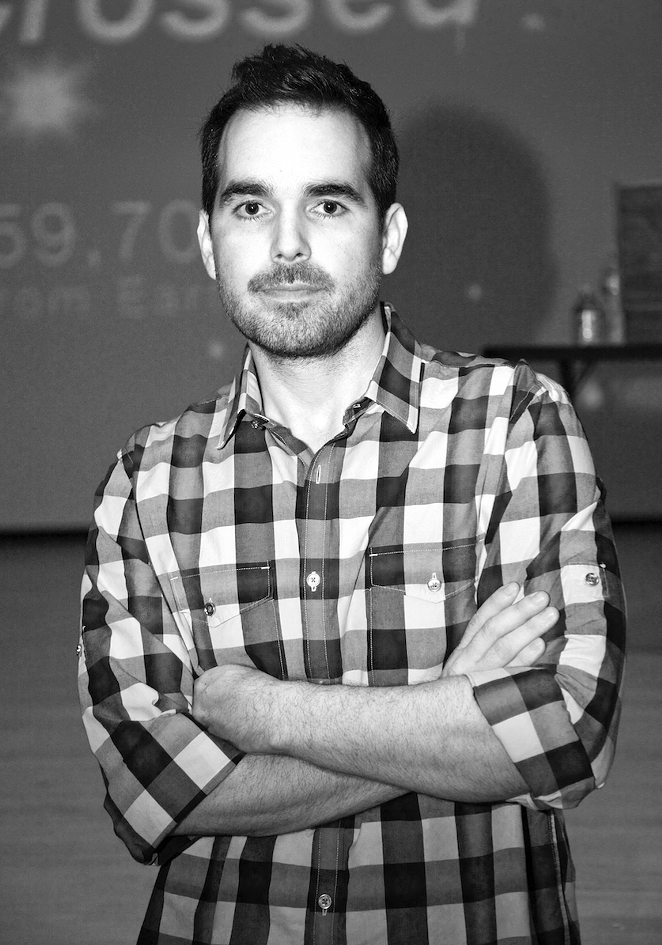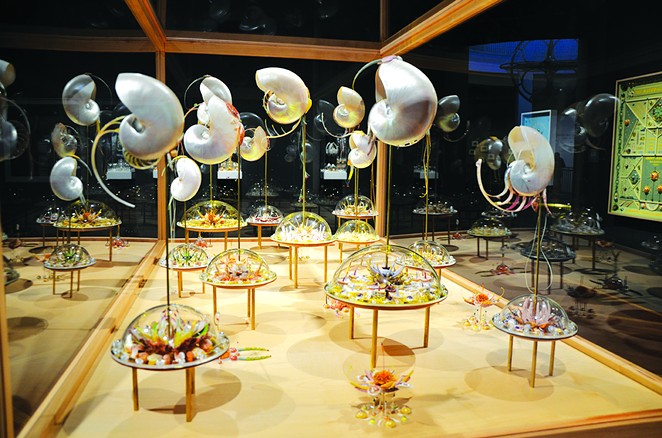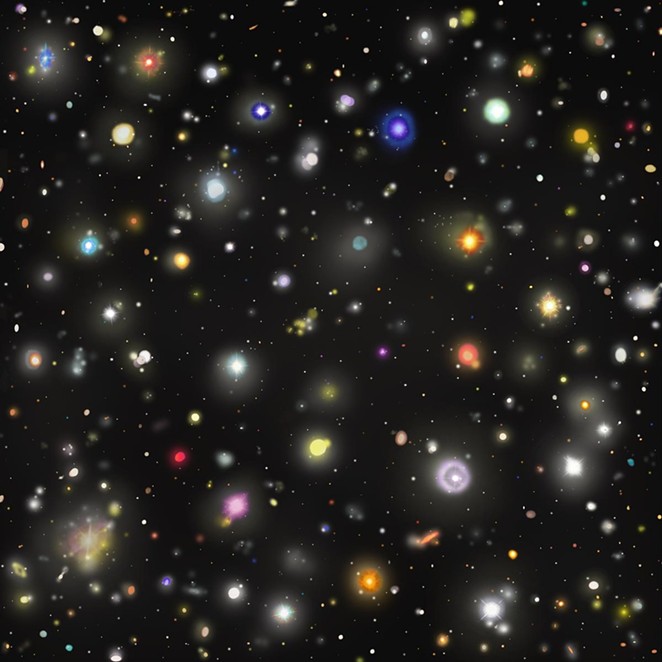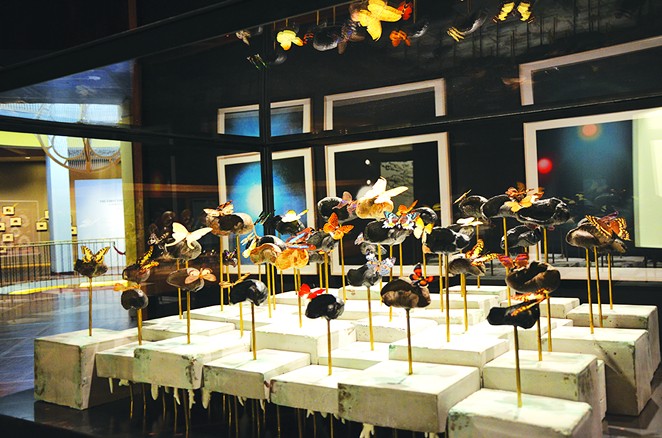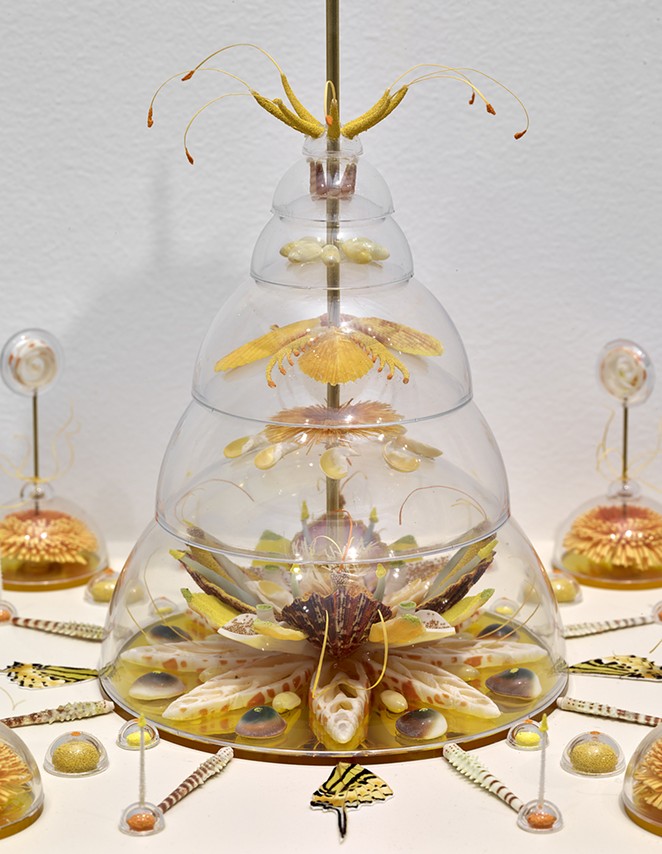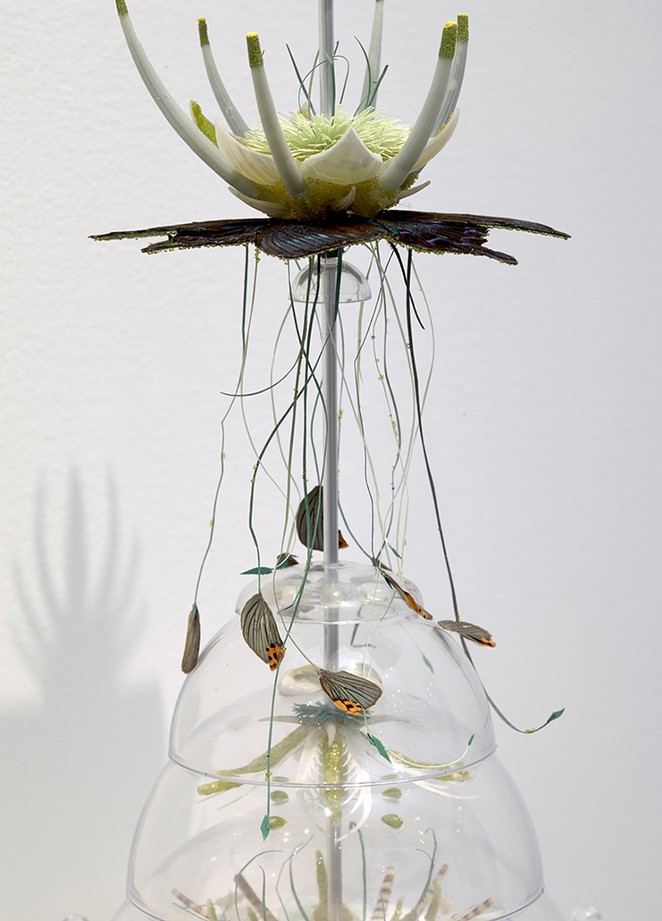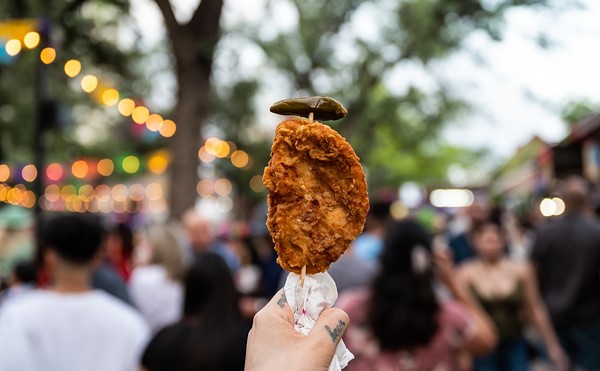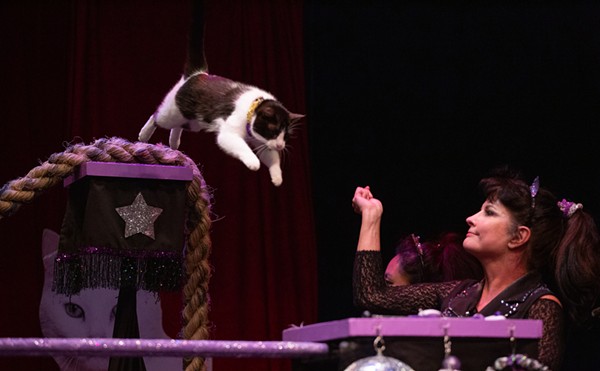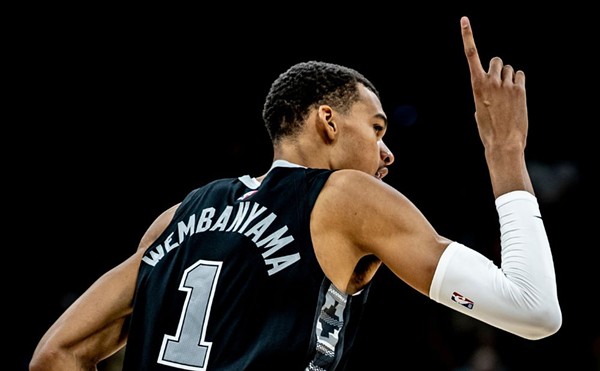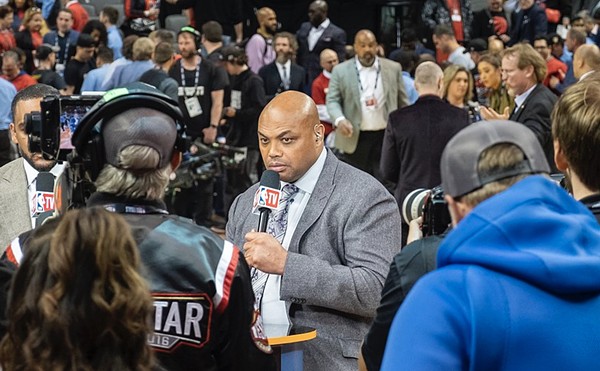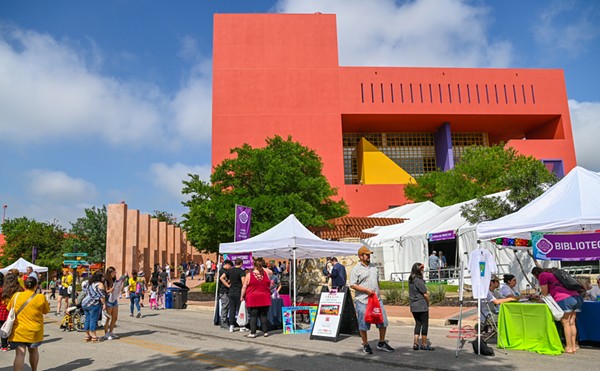The Alchemist: The McNay Opens a Window into the Fascinating Work of San Antonio Native Dario Robleto
By Bryan Rindfuss on Wed, Jul 11, 2018 at 11:30 am
Too often within the realm of contemporary art, viewers are left searching for clues, grasping for context and wondering if they even “get” whatever it is they’re looking at. Sometimes there’s not much to “get” after all, fueling arguments that contemporary art is pretentious, soulless or self-serving. The very opposite is true — and crystal clear — in the wide-ranging work of San Antonio-born, Houston-based artist Dario Robleto. One of San Antonio’s most celebrated artistic exports, Robleto has exhibited all over the U.S., is represented in numerous permanent collections (the Whitney Museum of American Art, Hirshhorn Museum and Sculpture Garden, the New Museum of Contemporary Art, Los Angeles County Museum of Art and the Menil Collection among them) and is currently an artist-in-residence at the Search for Extraterrestrial Intelligence (SETI) Institute.
Deeply inspired by DJ culture and the uncharted intersections between art and science, Robleto creates works that encompass a vast assortment of media. While certain projects, like 2014’s American Seabed, transport seashells, butterflies, “fossilized prehistoric whale ear bones” and other elements into complex assemblages that suggest preserved slices of otherworldly ecosystems, others sample imagery — such as his triptych Survival Does Not Lie in the Heavens, which presents “stage lights taken from the album covers of live performances of now-deceased gospel, blues and jazz musicians” in constellations reminiscent of distant galaxies captured by the Hubble Space Telescope.
Music and recorded sound are common threads, creeping into sculptural arrangements in the form of “butterfly antennae made from stretched and pulled audiotape recordings of Bob Dylan’s ‘Desolation Row’” or bones filled with “marrow” made from melted vinyl records. Poetry and language also play a key role, evidenced by such imaginative offerings as If We Do Ever Get Any Closer at Cloning Ourselves Please Tell My Scientist-Doctor to Use Motown Records as My Connecting Parts, a large-scale, laboratory-like installation he created in San Antonio as an Artpace resident in 2000. Arguably less obvious is Robleto’s life-long fascination with SETI and The Golden Record, a 12-inch, gold-plated time capsule NASA launched into space in 1977 in an attempt to “communicate a story of our world to extraterrestrials.”
As difficult as it might be to visualize, these various lines of creative inquiry criss-cross cohesively in the McNay’s “Ancient Beacons Long for Notice,” a compact survey comprising mixed-media collages, prints, intricate assemblages and The First Time, the Heart — a series of 50 photolithographs based on early recordings of the human heart reacting to situations ranging from an “experiment with cannabis” in 1874 to a case of hiccups in 1886. On the day the exhibition opened to the public, Robleto sat down with the Current to talk about the breadth of his work, divisions between disciplines, butterfly dealers and SETI’s “little green men problem.” If you had to select one visual thing you were best known for, what would it be?
My relationship to sound, maybe specifically to vinyl records, is sort of how I got my beginning. I did these early works where I would melt vinyl records and make sculptures from them. That was fueled by my passion for DJ culture. My relationship to sound is everywhere in the things I do ... Although my body of work now with the sound of the heart ... I think that’s probably getting more and more traction ... It’s been six years now that I’ve been doing various projects like this with the heart.
I’m seeing quite a bit of text in your work. Can you tell me a little bit about where that’s coming from?
Many years ago, I came up for this term for myself, which is “materialist poet.” I needed to find a way to say up front that the language is just as important as the material. And I do something kind of odd I think, for object-makers, which is the title and the medium list come first ... Many artists [use] “Untitled, mixed media, dimensions variable.” To me, that’s a wasted opportunity. It’s a poetic form, like a haiku. It has its own logic, rhythm and structure ... To connect it to music, some of my earliest, truly joyous, aesthetic experiences came from getting home with my new record and pulling the lyric sheet out ... The relationship of the text to the art was always just sort of hardwired into me.
Would you read the lyrics as the record was playing?
Oh god, yes. Even when I became an artist, I always thought, why can’t someone get home with their new sculpture and get to sing along with it right away? I’m curious about sourcing of materials in some of your larger assemblage pieces. Where do you turn to find butterflies and acrylic domes and all the various parts?
I have a basic philosophy about this, which is: If I can find it myself, I will. And what that means is, I generally avoid things like eBay. Because I want the experience of finding it. And I’m such a big believer in first-hand knowledge, learning through doing. So, like the domes, I need a fabricator to make that, and I work with them because they’re all highly specific shapes. But like the whale ear bones, I’m an avid fossil hunter myself. I’m part of other fossil collecting groups. So, if I use a fossil in my work, I’ve generally gone to find it.
So did you find the fossilized whale ear bones in this show?
Many of them I did, yes. Where to find them is more known, because it tends to be where now-established oceans once were.
Can you give me an example?
Actually North Carolina is a place where you can find a lot of them, oddly. And we’re talking about an ocean from 10 million years ago, too. It seems unusual but it’s just because we’re looking at it today ... The butterflies, I’m part of so many different collecting circles — shells, butterflies, fossils ... I remember one day getting a message on my phone and the oddness of what I did really sunk in. This dinosaur dealer I have, he called and said, “Dario, I got your dinosaur bones in, would you like to come pick [them] up?” It’s just a funny thing, in our day and age to have …
A dinosaur dealer?
Yes. I did another project where I just wanted the first creatures that we likely pushed to extinction. So I just wanted those dinosaur bones.
Do you also have a butterfly dealer?
I do, yes, several, depending on what part of the world they’re from. What can you tell me about your residency with SETI and what it entails?
I have a lifelong fascination with the topic and the SETI Institute. So, to be asked to actually get to work with those scientists was just like a dream come true ... I’m over two years in as a resident, but decades of thinking about the problem. And what I’ve really come to realize is that SETI has what I call a “little green men problem.” In that the cultural understanding of alien-ness is so dominated by invasion, violence, aggression, that it’s hard for us to even bring it up. You’ve got to get past the baggage of it. And, as an artist, I feel one of the things I can do, beyond what I make, is to help rethink this narrative. Because I argue that it is the most profound question we can ask: Are we alone? Either way you answer it, it’s amazing. Either we are the only intelligent life — which, think about that — or we’re not — which, think about that.
They’re equally scary.
Yes. And profound in the history of the human intellect to ask questions. To really ponder one’s place in the cosmos at that level ... [It’s] disappointing that culturally we can’t get past the sort of giggling part of it. And so what SETI does ... is hard science done by hard scientists. It’s not about crop circles. It’s not about abduction. That’s pop culture. This is using what we know about astronomy, physics, light, astrobiology ... In all of my work, I’m always making the case that there’s a value for artists to be involved.
Have you created work specifically related to that line of inquiry?
Yes. These are the first [pieces] trickling out of the studio. The big seashell piece and the five collages, a series of small sculptures, even the whale ear bone piece. At its core, all of those works are talking about the problem of how do you communicate with something that’s not you? A lot of my work with SETI is about this: How do you imagine something you can’t imagine? And then how do you communicate with it? Is there such a thing as universal communication? We have problems on our own planet just communicating human-to-human, let alone [with] something you can’t imagine. So, it’s a great philosophical problem, to think about what’s the most fundamental way life makes itself known ... You ask almost any SETI scientist, and they’re always going to give you an answer, which is math. And I see the logic of that ... If you have one shot to say something, what would you say? They argue [for] math. Because as far as we know, math and physics are universal. Two plus two equals four on the other side of the universe.
Do you have a background in science and math as well?
Not math, but I actually began as a biology major. And when I became an artist, it never occurred to me not to bring the science with me. And in fact, much of my practice as an artist has now become to challenge and completely argue against the assumed divisions between art and science. I just don’t accept them ... Maybe the science will progress if you actually take into consideration the poetic concerns. And vice-versa, maybe my work changes in a way if I stay true to the demands of science. And I love that tension as a way of being creative.
You could potentially uncover something that they’re not seeing.
Exactly ... And this is a deeper educational problem in our country, about the divisions of disciplines. In my experience with scientists, they think of us in the most clichéd way — like we slap a painting on a canvas. They’ve lost touch with the fact that art is much older than science ... We have much more in common than difference. And I think it’s been a horrible thing that our culture has divided the two, so I’m always trying to poke at it.
Have you thought about what The Golden Record would sound like if it were made today?
I have, a lot ... I don’t know if it even could get made today, which is a sort of humbling thing to say.
What should be on it if it were made today?
Well, [the things] they chose are fantastic. There’s sounds of the natural world, there’s music, there are images. But famously, there’s no art on board. They specifically chose not to deal with art ... They realized they just didn’t have the expert on the team ... Of all the things that may be remembered of what we’re capable of, it’s such a source of sadness to me that art is not on the table ... So that’s where I would start. Now you get into an incredibly complicated problem of “what art.” But that’s the fun of it, too.
But do you have a playlist in mind?
I do. And it’s more sound ... For example, I would like to put on board the moment we crossed the threshold into sound recording. Just historically to show, here’s the first time in history we solved the problem of long-term preservation of one of the most ephemeral senses we have. Like everything that’s going on in your phone right now, we don’t even reflect on [the fact that] we can do it. Edison didn’t invent this until 1877. Until 1877, and really a few decades more until it got going, the mass, sum total of all audible history, all of our great singers, orators, musicians, just the sound of the Victorian city, or any city on the planet, we don’t know. It’s just not here. It’s gone. And I always like to say, too, think of if our only knowledge of Patsy Cline was through reading transcripts of her performances. And that, to me, hits home, to what actually the bulk of recorded sound history in our planet is … [and] what we’re all missing.
Being a San Antonio native living in Houston, I’m curious what you would say about the difference between the cities’ art scenes.
That’s an interesting question. [Houston] is naturally a bigger scene. But one thing I find in common is that San Antonio is really good about a sense of community in the arts. And Houston, I always argue, is right on this incredible threshold where it’s big enough that it has really healthy, multiple scenes, but it’s not so big that you couldn’t probably know it all if you really tried ... San Antonio, I feel, just because it’s a little bit smaller, you can still kind of know it all. But the sense of community is what I’m equally drawn to ... In San Antonio and in Houston, I’ve always felt that I want my fellow artists to succeed, just as I feel that they want me to succeed. Because we still have a sense of “let’s all succeed.” I don’t know how long [we] can maintain that. But that’s a beautiful thing. And highly unusual in the larger art world.
And the market must be largely different.
Very different. Yes, the money is very different. There is much more support financially in Houston at every level — [from] DIY to the blue-chip gallery all the way to our incredible museums. San Antonio has never quite solved the collecting problem — having enough contemporary collectors to help fund younger artists. Houston definitely has that.
And you think those collectors keep an eye on supporting locals?
It’s also a problem. There’s always this tendency, wherever you are, to think that what’s not in your city is more interesting. And you kind of sometimes lose sight of what’s happening right there ... In my experience, it takes a special type of collector to want to say, “I’m an advocate for right here, and I’m going to show it financially.” That’s a smaller breed, but Houston’s big enough that it has many of those.
I’ve always heard that there’s a lot of art being sold in Houston but it’s not necessarily made there.
Right, and that’s where that’s coming from. There’s a truth to it, but not so much that there’s not a healthy support system for artists there. Even like myself, I’m a Houstonian, but a lot of my sales aren’t by Houstonians themselves. Although I have tremendous support there. It’s an interesting psychological phenomenon. Like why do you have trouble seeing what’s right in front of you? And when it comes to young artists, that’s not a good thing.
Ancient Beacons Long for Notice
$10-$20, 10am-4pm Wed, 10am-9pm Thu, 10am-4pm Fri, 10am-5pm Sat, noon-5pm Sun, 10am-4pm Tue, McNay Art Museum, 6000 N. New Braunfels Ave., (210) 824-5368, mcnayart.org
Stay on top of San Antonio news and views. Sign up for our Weekly Headlines Newsletter.
Deeply inspired by DJ culture and the uncharted intersections between art and science, Robleto creates works that encompass a vast assortment of media. While certain projects, like 2014’s American Seabed, transport seashells, butterflies, “fossilized prehistoric whale ear bones” and other elements into complex assemblages that suggest preserved slices of otherworldly ecosystems, others sample imagery — such as his triptych Survival Does Not Lie in the Heavens, which presents “stage lights taken from the album covers of live performances of now-deceased gospel, blues and jazz musicians” in constellations reminiscent of distant galaxies captured by the Hubble Space Telescope.
Music and recorded sound are common threads, creeping into sculptural arrangements in the form of “butterfly antennae made from stretched and pulled audiotape recordings of Bob Dylan’s ‘Desolation Row’” or bones filled with “marrow” made from melted vinyl records. Poetry and language also play a key role, evidenced by such imaginative offerings as If We Do Ever Get Any Closer at Cloning Ourselves Please Tell My Scientist-Doctor to Use Motown Records as My Connecting Parts, a large-scale, laboratory-like installation he created in San Antonio as an Artpace resident in 2000. Arguably less obvious is Robleto’s life-long fascination with SETI and The Golden Record, a 12-inch, gold-plated time capsule NASA launched into space in 1977 in an attempt to “communicate a story of our world to extraterrestrials.”
As difficult as it might be to visualize, these various lines of creative inquiry criss-cross cohesively in the McNay’s “Ancient Beacons Long for Notice,” a compact survey comprising mixed-media collages, prints, intricate assemblages and The First Time, the Heart — a series of 50 photolithographs based on early recordings of the human heart reacting to situations ranging from an “experiment with cannabis” in 1874 to a case of hiccups in 1886. On the day the exhibition opened to the public, Robleto sat down with the Current to talk about the breadth of his work, divisions between disciplines, butterfly dealers and SETI’s “little green men problem.” If you had to select one visual thing you were best known for, what would it be?
My relationship to sound, maybe specifically to vinyl records, is sort of how I got my beginning. I did these early works where I would melt vinyl records and make sculptures from them. That was fueled by my passion for DJ culture. My relationship to sound is everywhere in the things I do ... Although my body of work now with the sound of the heart ... I think that’s probably getting more and more traction ... It’s been six years now that I’ve been doing various projects like this with the heart.
I’m seeing quite a bit of text in your work. Can you tell me a little bit about where that’s coming from?
Many years ago, I came up for this term for myself, which is “materialist poet.” I needed to find a way to say up front that the language is just as important as the material. And I do something kind of odd I think, for object-makers, which is the title and the medium list come first ... Many artists [use] “Untitled, mixed media, dimensions variable.” To me, that’s a wasted opportunity. It’s a poetic form, like a haiku. It has its own logic, rhythm and structure ... To connect it to music, some of my earliest, truly joyous, aesthetic experiences came from getting home with my new record and pulling the lyric sheet out ... The relationship of the text to the art was always just sort of hardwired into me.
Would you read the lyrics as the record was playing?
Oh god, yes. Even when I became an artist, I always thought, why can’t someone get home with their new sculpture and get to sing along with it right away? I’m curious about sourcing of materials in some of your larger assemblage pieces. Where do you turn to find butterflies and acrylic domes and all the various parts?
I have a basic philosophy about this, which is: If I can find it myself, I will. And what that means is, I generally avoid things like eBay. Because I want the experience of finding it. And I’m such a big believer in first-hand knowledge, learning through doing. So, like the domes, I need a fabricator to make that, and I work with them because they’re all highly specific shapes. But like the whale ear bones, I’m an avid fossil hunter myself. I’m part of other fossil collecting groups. So, if I use a fossil in my work, I’ve generally gone to find it.
So did you find the fossilized whale ear bones in this show?
Many of them I did, yes. Where to find them is more known, because it tends to be where now-established oceans once were.
Can you give me an example?
Actually North Carolina is a place where you can find a lot of them, oddly. And we’re talking about an ocean from 10 million years ago, too. It seems unusual but it’s just because we’re looking at it today ... The butterflies, I’m part of so many different collecting circles — shells, butterflies, fossils ... I remember one day getting a message on my phone and the oddness of what I did really sunk in. This dinosaur dealer I have, he called and said, “Dario, I got your dinosaur bones in, would you like to come pick [them] up?” It’s just a funny thing, in our day and age to have …
A dinosaur dealer?
Yes. I did another project where I just wanted the first creatures that we likely pushed to extinction. So I just wanted those dinosaur bones.
Do you also have a butterfly dealer?
I do, yes, several, depending on what part of the world they’re from. What can you tell me about your residency with SETI and what it entails?
I have a lifelong fascination with the topic and the SETI Institute. So, to be asked to actually get to work with those scientists was just like a dream come true ... I’m over two years in as a resident, but decades of thinking about the problem. And what I’ve really come to realize is that SETI has what I call a “little green men problem.” In that the cultural understanding of alien-ness is so dominated by invasion, violence, aggression, that it’s hard for us to even bring it up. You’ve got to get past the baggage of it. And, as an artist, I feel one of the things I can do, beyond what I make, is to help rethink this narrative. Because I argue that it is the most profound question we can ask: Are we alone? Either way you answer it, it’s amazing. Either we are the only intelligent life — which, think about that — or we’re not — which, think about that.
They’re equally scary.
Yes. And profound in the history of the human intellect to ask questions. To really ponder one’s place in the cosmos at that level ... [It’s] disappointing that culturally we can’t get past the sort of giggling part of it. And so what SETI does ... is hard science done by hard scientists. It’s not about crop circles. It’s not about abduction. That’s pop culture. This is using what we know about astronomy, physics, light, astrobiology ... In all of my work, I’m always making the case that there’s a value for artists to be involved.
Have you created work specifically related to that line of inquiry?
Yes. These are the first [pieces] trickling out of the studio. The big seashell piece and the five collages, a series of small sculptures, even the whale ear bone piece. At its core, all of those works are talking about the problem of how do you communicate with something that’s not you? A lot of my work with SETI is about this: How do you imagine something you can’t imagine? And then how do you communicate with it? Is there such a thing as universal communication? We have problems on our own planet just communicating human-to-human, let alone [with] something you can’t imagine. So, it’s a great philosophical problem, to think about what’s the most fundamental way life makes itself known ... You ask almost any SETI scientist, and they’re always going to give you an answer, which is math. And I see the logic of that ... If you have one shot to say something, what would you say? They argue [for] math. Because as far as we know, math and physics are universal. Two plus two equals four on the other side of the universe.
Do you have a background in science and math as well?
Not math, but I actually began as a biology major. And when I became an artist, it never occurred to me not to bring the science with me. And in fact, much of my practice as an artist has now become to challenge and completely argue against the assumed divisions between art and science. I just don’t accept them ... Maybe the science will progress if you actually take into consideration the poetic concerns. And vice-versa, maybe my work changes in a way if I stay true to the demands of science. And I love that tension as a way of being creative.
You could potentially uncover something that they’re not seeing.
Exactly ... And this is a deeper educational problem in our country, about the divisions of disciplines. In my experience with scientists, they think of us in the most clichéd way — like we slap a painting on a canvas. They’ve lost touch with the fact that art is much older than science ... We have much more in common than difference. And I think it’s been a horrible thing that our culture has divided the two, so I’m always trying to poke at it.
Have you thought about what The Golden Record would sound like if it were made today?
I have, a lot ... I don’t know if it even could get made today, which is a sort of humbling thing to say.
What should be on it if it were made today?
Well, [the things] they chose are fantastic. There’s sounds of the natural world, there’s music, there are images. But famously, there’s no art on board. They specifically chose not to deal with art ... They realized they just didn’t have the expert on the team ... Of all the things that may be remembered of what we’re capable of, it’s such a source of sadness to me that art is not on the table ... So that’s where I would start. Now you get into an incredibly complicated problem of “what art.” But that’s the fun of it, too.
But do you have a playlist in mind?
I do. And it’s more sound ... For example, I would like to put on board the moment we crossed the threshold into sound recording. Just historically to show, here’s the first time in history we solved the problem of long-term preservation of one of the most ephemeral senses we have. Like everything that’s going on in your phone right now, we don’t even reflect on [the fact that] we can do it. Edison didn’t invent this until 1877. Until 1877, and really a few decades more until it got going, the mass, sum total of all audible history, all of our great singers, orators, musicians, just the sound of the Victorian city, or any city on the planet, we don’t know. It’s just not here. It’s gone. And I always like to say, too, think of if our only knowledge of Patsy Cline was through reading transcripts of her performances. And that, to me, hits home, to what actually the bulk of recorded sound history in our planet is … [and] what we’re all missing.
Being a San Antonio native living in Houston, I’m curious what you would say about the difference between the cities’ art scenes.
That’s an interesting question. [Houston] is naturally a bigger scene. But one thing I find in common is that San Antonio is really good about a sense of community in the arts. And Houston, I always argue, is right on this incredible threshold where it’s big enough that it has really healthy, multiple scenes, but it’s not so big that you couldn’t probably know it all if you really tried ... San Antonio, I feel, just because it’s a little bit smaller, you can still kind of know it all. But the sense of community is what I’m equally drawn to ... In San Antonio and in Houston, I’ve always felt that I want my fellow artists to succeed, just as I feel that they want me to succeed. Because we still have a sense of “let’s all succeed.” I don’t know how long [we] can maintain that. But that’s a beautiful thing. And highly unusual in the larger art world.
And the market must be largely different.
Very different. Yes, the money is very different. There is much more support financially in Houston at every level — [from] DIY to the blue-chip gallery all the way to our incredible museums. San Antonio has never quite solved the collecting problem — having enough contemporary collectors to help fund younger artists. Houston definitely has that.
And you think those collectors keep an eye on supporting locals?
It’s also a problem. There’s always this tendency, wherever you are, to think that what’s not in your city is more interesting. And you kind of sometimes lose sight of what’s happening right there ... In my experience, it takes a special type of collector to want to say, “I’m an advocate for right here, and I’m going to show it financially.” That’s a smaller breed, but Houston’s big enough that it has many of those.
I’ve always heard that there’s a lot of art being sold in Houston but it’s not necessarily made there.
Right, and that’s where that’s coming from. There’s a truth to it, but not so much that there’s not a healthy support system for artists there. Even like myself, I’m a Houstonian, but a lot of my sales aren’t by Houstonians themselves. Although I have tremendous support there. It’s an interesting psychological phenomenon. Like why do you have trouble seeing what’s right in front of you? And when it comes to young artists, that’s not a good thing.
Ancient Beacons Long for Notice
$10-$20, 10am-4pm Wed, 10am-9pm Thu, 10am-4pm Fri, 10am-5pm Sat, noon-5pm Sun, 10am-4pm Tue, McNay Art Museum, 6000 N. New Braunfels Ave., (210) 824-5368, mcnayart.org
Stay on top of San Antonio news and views. Sign up for our Weekly Headlines Newsletter.

KEEP SA CURRENT!
Since 1986, the SA Current has served as the free, independent voice of San Antonio, and we want to keep it that way.
Becoming an SA Current Supporter for as little as $5 a month allows us to continue offering readers access to our coverage of local news, food, nightlife, events, and culture with no paywalls.
Scroll to read more Arts Stories & Interviews articles
Newsletters
Join SA Current Newsletters
Subscribe now to get the latest news delivered right to your inbox.

